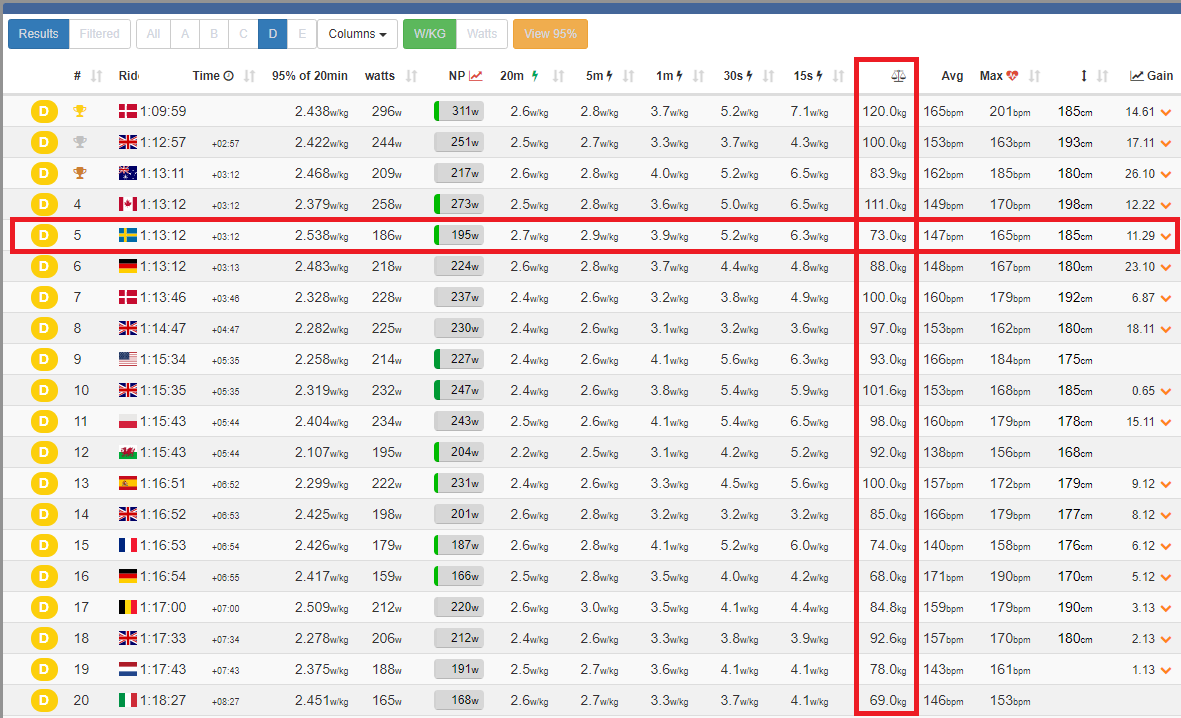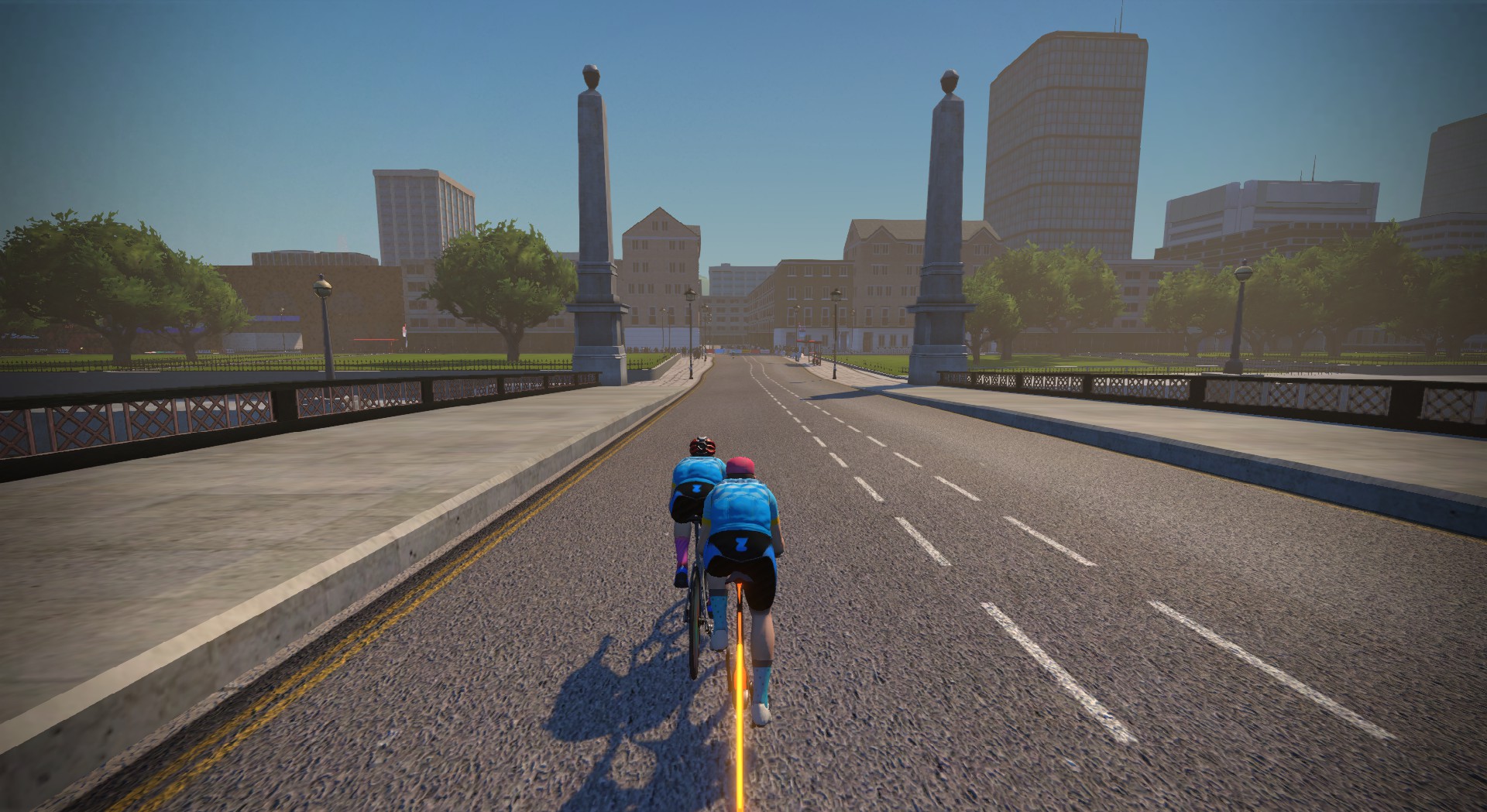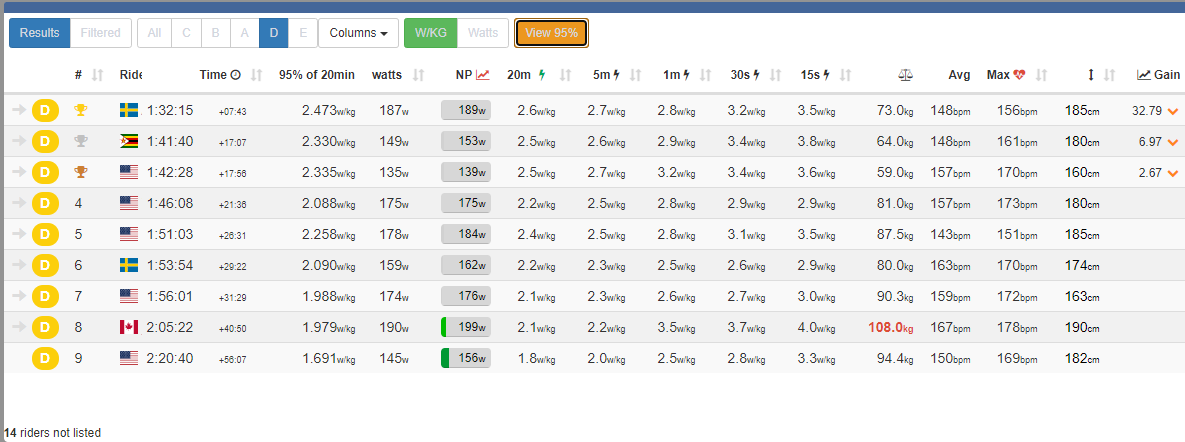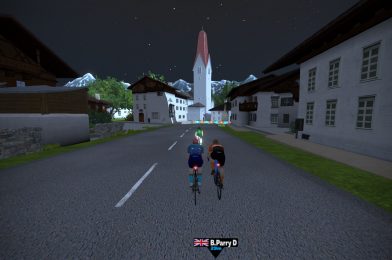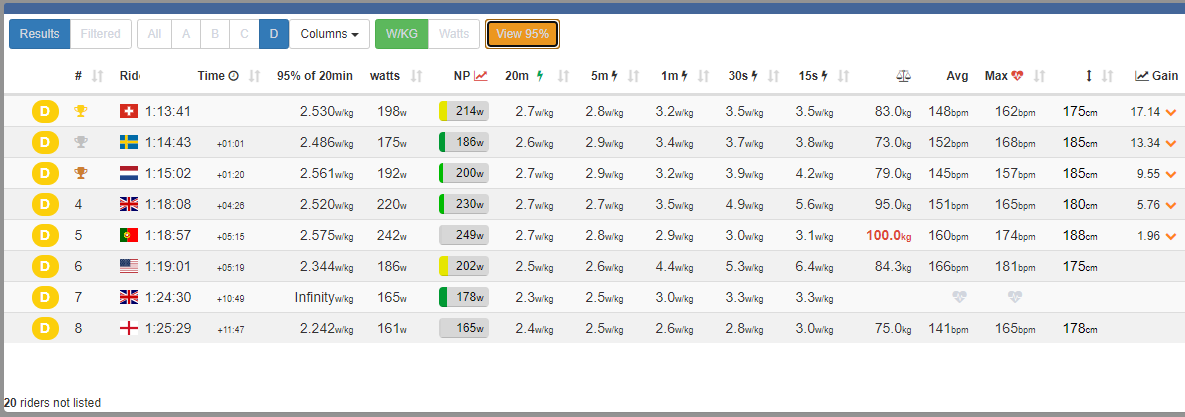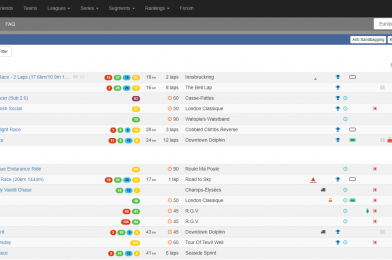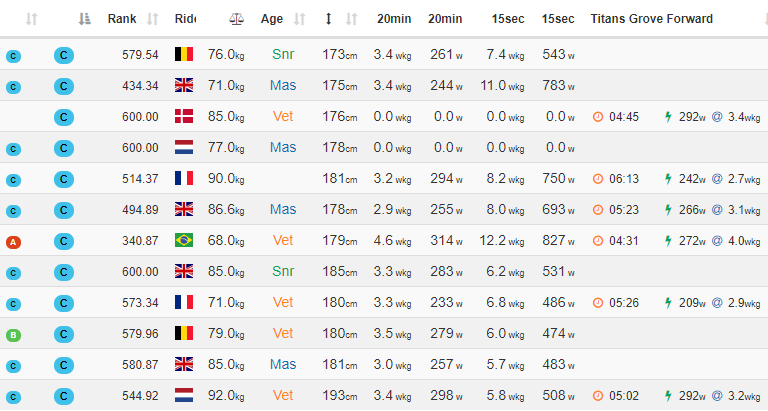In this lesson we are going to talk about the core skill in cruising, which is managing your 20 min average W/kg. As long as you can handle that you are effectively cruising. It’s like learning to hold a fishing rod. Once you know how, you just sit there and wait to catch a goldfish. You don’t always catch one, but as long as you are patient and keep a firm grip on the rod the fish will come sooner or later. You will win way more races on average than any legit racer could ever do.
Monitoring Your Average
When I talk about “your average” I always refer to your current 20 min average W/kg. You can find your best 20 min average in ZP’s race report tables under the avg heading, which turns into a 95% of 20 min if you click the orange View 95% button, which should generally be clicked. But that is old information, after the race. You need to have an idea of what your best average and your current average is all the time during the actual race. If you don’t you will most likely go over cat limits since you race with overcapacity as a cruiser. If you know your averages, it becomes easy to make sure you don’t go over limits. But how do you know what your best average or current average is during the race?
It is awfully hard to gauge the average without some kind of meter to look at. Don’t even try it. And by meter I don’t mean the Watt or W/kg meter on your Zwift screen. They will move up and down a lot, making it hard to judge what those movements average to, and you need to be fairly exact when cruising because you are looking to stay as close to cat limits as you dare. And besides, even if you had some savant ability to actually guesstimate your total race average, then that information is useless. What you want to know is your 20 min averages.
You will need some kind of third-party help because Zwift doesn’t provide the data you need. Luckily, there is easily available help.
A Crude Method
I myself use a very crude method to keep track of my averages because that is all I have access to at this time. It sort of works but it isn’t perfect. Since I use a Wahoo Kickr Core smart trainer I have the Wahoo app (previously Wahoo Fitness) installed on my mobile which goes onto the handlebars in every race with a QuadLock. I run Zwift on a PC through an ANT+ connection and the Wahoo app connects to the smart trainer via BlueTooth. The Zwift Companion app connects to the Zwift PC app via WiFi and I have it on but I’m rarely using it in a race, which is half the explanation to why you will never get a RideOn from me during a race (the other half is I couldn’t stomach to give people rideons while I’m cheating). Instead I’m constantly keeping an eye on the Wahoo app because it provides me with crucial information. Or should I say cruisial?
I’m not sure the Tacx app can provide the similar real-time numbers, but I would guess so. I don’t remember. I never really liked my previous Neo 2, it felt too articial. As for Elite or other smart trainer brands, I couldn’t say. Have a look if you own such a trainer. Other options would be bicycle computers like Garmin or possibly power meter pedal or crank apps. Or if you happen to be a programmer who likes to play around with hardware SDK’s and the BlueTooth protocol, then you could make an app of your own, I guess. That would actually be ideal and I will come to why. Anyway, investigate your options.
Here is what the Wahoo app shows me in real-time:
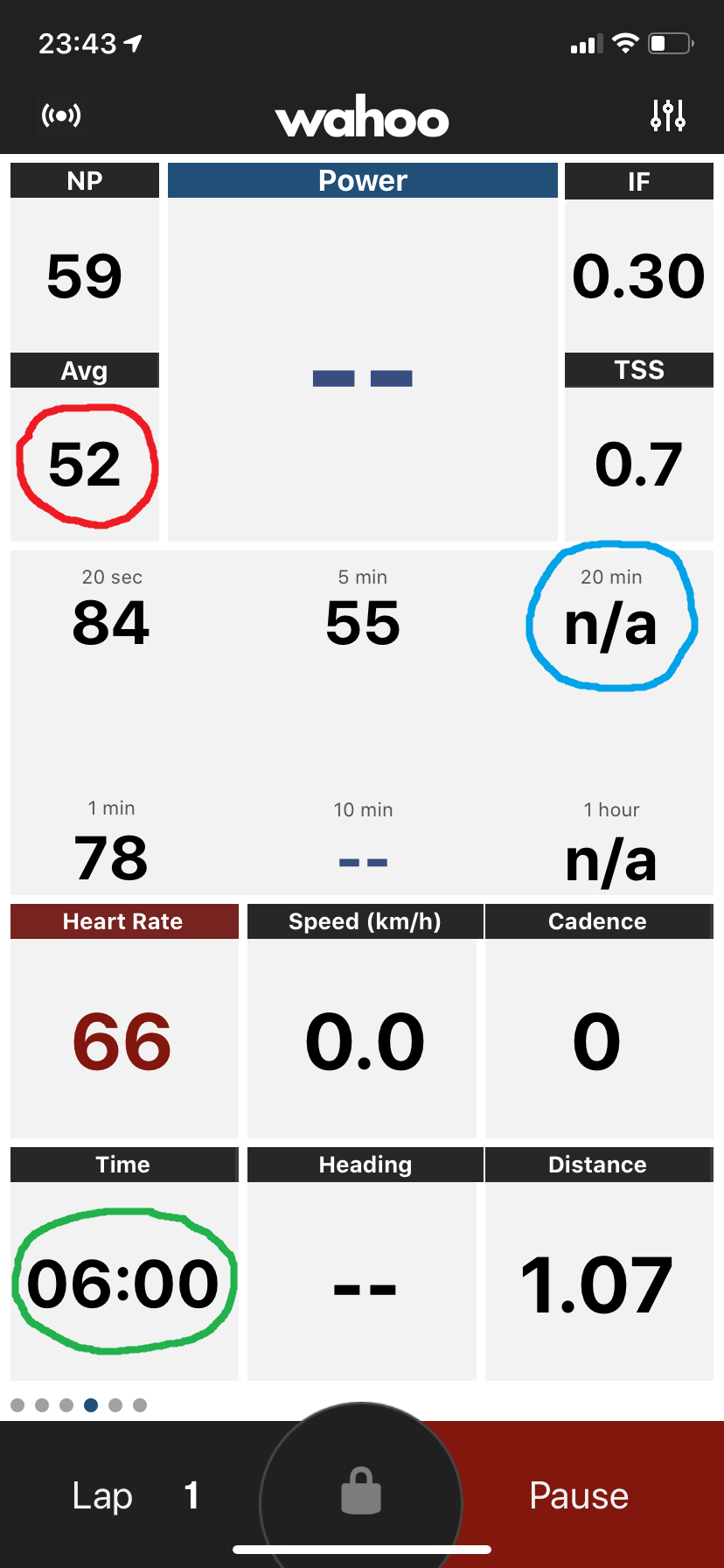
I start a workout recording in the app exactly when the race starts. The red circle is the total average Watt since the start, so it’s the total average. The green circle shows the total time elapsed in the workout so far. The blue circle shows the best 20 min Watt effort since the workout was started, which can be useful if you want to do an FTP test on your own outside of Zwift or even outdoors if you have a power meter and a Wahoo bicycle computer.
This is not ideal information at all. What you would need is a trailing 20 min average, i.e. your last 20 min. If you had, that then cruising within cat limits would be extremely simple. Just look at the trailing average as you race and make sure it never rises above limits. But in the lack of a trailing average I am forced to make do with the three colored circles. It works OK’ish, but it isn’t foolproof. Below is a lengthy explanation of how I do it.
Setting Your Personal Race Limits
Since the Wahoo app doesn’t show W/kg but Watt rather, I have to do some calculations before the race. Right now I weigh 75 kg. And I have one race result slightly over limits in my ZP 90-day best three average. My 90-day average is currently ridiculously close to an upgrade and looks like this:
(2.521 + 2.495 + 2.483) / 3 = 2.4996666667
A gust of wind would tip that average over to 2.500 and an upgrade. The lowest race result in the best three is 2.483 W/kg. I must never go harder than 2.483 W/kg in any 20 min period in any race. How much is that in Watt given my weight, so that I can set a limit for myself for the Wahoo app?
2.483 W/kg * 75 kg = 186W
But we are forgetting something here. The 2.483 W/kg is an adjusted number. ZP looks at your best 20 min and then multiplies it by 0.95, treating your 20 min as an FTP test for the race. It is not your 20 min performance that cannot hit the cat limit but rather your assumed 1 hr performance. So we have to deadjust that race result and then redo the calculation.
2.483 W/kg / 0.95 = 2.613 (rounded down on purpose)
2.613 W/kg * 75 kg = 195.975 W (we round it down to 195W to be on the safe side)
Thus, as long as I never average above 195 W in any 20 min period in any race, then my 90-day best three average will never hit 2.5 W/kg and I won’t get upgraded. If I stay very close to those 195W I also have a good chance to win races because I am then operating right under the cat D performance ceiling. You can’t go much faster than that in cat D. You are not allowed to.
Typically, I will aim a little lower than 195W. If I can get the average down to something like 193W for the first hectic 20 min in a race, then I will feel better about it. Surprisingly often, though, it comes down to a choice between either dropping from a group at a race time like 00:18:37 or pushing those 193W just a tad higher. If I drop from that early group the race could be lost. If I stay with them I could risk going over limits and lose my cheater’s license. Be prepared for constant hard choices when cruising!
20 Min Periods vs 20 Min Blocks
What ZP looks at is your best 20 min period in a race. And that period could happen any time. Usually it’s the very first 20 min of the race and this is because the starts are almost always very hard, which pushes up the initial average. But you could end up in a race which starts in easy terrain but ends up in a climb, e.g. in one lap around the Lutscher route. Let’s say the bunch doesn’t push the initial descent too hard at race start but then some light guys drive up the pace in the finishing climb. Then your best 20 min period could be the very last 20 min of the race instead. This is a rare situation though, so since more often than not your first 20 min will be the hardest in terms of Watt output, and since e.g. the Wahoo app doesn’t show a trailing 20 min average, then it becomes meaningful to also think about the race as divided into consecutive 20 min blocks.
So let’s say you knew in advance that the first 20 min would be your best 20 min in terms of Watt in a race. Then your best 20 min period will happen in the first 20 min block. They will coincide. And let’s say you manage your average carefully in those first 20 min. You manage to not go over your set personal limit. Then once the race clock hits 00:20:00 the worst part is over. You know that the risk of going over limit is drastically reduced and you can relax more.
You never know in advance though. But let’s say you notice that your average Watt start to drop in the latter half of the first 20 min after a very hard start because the group you are in is slowing down compared to the first crazy minutes. This is a very common scenario. People around you can’t keep that initial crazy pace up for very long. It’s just initial positioning and then things slow down a bit. But that also means that once the first 20 min are over, given that you didn’t go over limits, then you can forget about that 20 min block. Your high Watt during the first minutes won’t hurt the rest of the race.
The First 20 Min
It becomes easier to understand what happens during the first 20 min if we visualize it in a graph. The below graph illustrates how your momentary Watt output can change over the first 20 min in a successful cruise.
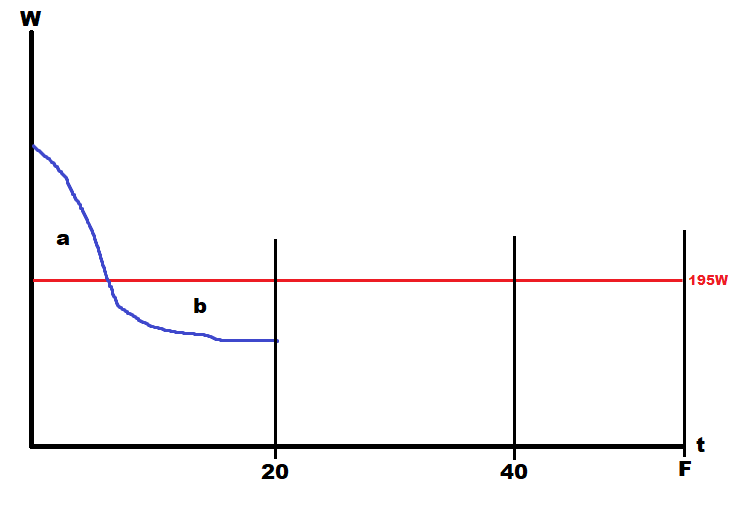
On the vertical axis is your Watt. On the horizontal axis is race time in minutes. The race finishes at F after like 55 min or so. The red line shows your personal limit for this race. We will use my limit of 195W for this example. Then we have the blue line which shows your Watt output and how it changes minute by minute during the first 20 min in a cat D race.
This race starts hard at Watt way above your limit. It drops after a while because no legit cat D’s can keep that pace up for long. And it has to drop or you will get a DQ. Actually, in order for you to dodge the DQ you are going to have to end the first 20 min below your limit as compensation for the high initial effort, or your average for the first block will become higher than your limit. We can intuitively see, when illustrating it like this, that there is a relationship between the first period of the block, when your Watt are above limit, and the second period, when your Watt need to be below limit. The relationship is this:
As long as the area a is not larger than the area b, then your average will end up below limit.
Put differently, you need to make sure that area b is roomy enough to be at least equal in size to area a, meaning you need to compensate for the initial high effort by going under limit for a while. If the initial effort in a was high, then the lower you go under your limit in the b part, the faster your average will recover. If you stay closer to your limit during b, then getting your average in line with your limit will take longer.
How do you match the areas of a and b from the saddle during a race? You don’t of course, not literally. The area thing is just for illustrating a principle and during the race you are riding in the blind. You don’t think about graphs at all. But you still have to follow the principle somehow or you will get DQ’d (it will become clearer how to do that under the next heading).
Wouldn’t it be more efficient to just keep a level 195W during the first 20 min? Well, your body would definitely agree. But your sense of race tactics wouldn’t, not unless you race in an individual time trial. Since everybody else brings out the hammer the first few minutes, you must too or you won’t get in a reasonably paced group that you can draft in for the rest of the race. So you suck it up. But the weak spot here is those compensatory minutes in the first block. It feels awkward to go under limit that much as a cruiser. However, it is the same for everyone in the race. It’s not just you, the cruiser. Legit racers who never compensate during the first 20 min will get upgraded, just because of those 20 min, even though they lack in staying power and are half toast and forced to race way below limit for the rest of the race due to their fitness level. It would suck to get upgraded under those conditions, but it actually happens all the time to people with relatively high 4 min power in their power curve and an eagerness to stay with the sandbaggers. Legit racers rarely plan to get upgraded. It just happens one day and they take it from there. You have been legit yourself and you know what it’s like.
The Average for the First 20 Min
Note that the blue line, your momentary power output, in the above graph is not at all what your average Watt will look like in the Wahoo app or similar. It will behave differently, more like the below graph, given that you cruise successfully during the first 20 min.
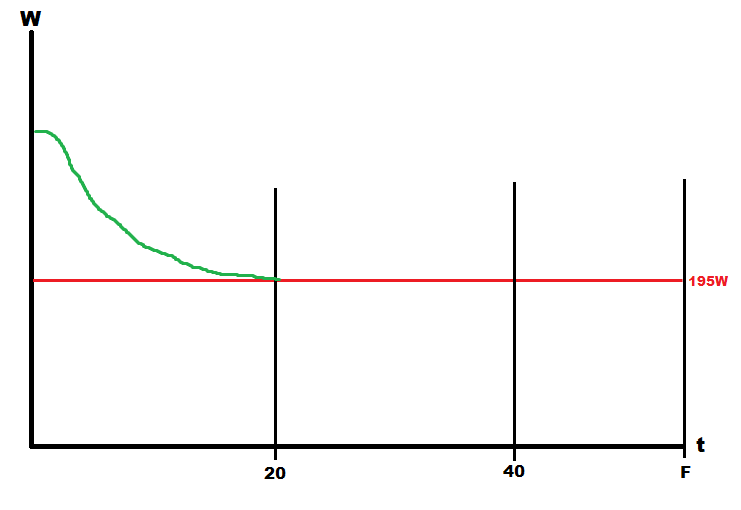
The green line is your average corresponding to the momentary Watt output in the previous graph (blue line). So your average will start high. Then, as your Watt output decreases, it will start to drop slowly. But as long as your Watt output is still above limit your average will be nowhere near limit. Even as you start compensating by going under limit in Watt output, the average will still trail behind for some time, above limit. And chances are you will only get the average down to meet the limit in the nick of time. That is actually optimal, but those last few minutes of the first 20 min block will be scary. Will you get the average down in time?
It is during the latter part of the first 20 min block where you will have to make some hard decisions. You can’t stay with the cat C’s and the cat D sandbaggers for very long or you will never get the average down in time before the first 20 min have run out. You will have to drop at some point, usually after 10-12 min. Preferably, you drop right into the arms of a nicely paced legit cat D group so that you can get the average down while in draft. Draft helps a lot in lowering your average quickly while still maintaining decent speed.
Those last minutes of the first 20 min block are usually the most difficult part in a cruised race. It’s the make or break part. Err on the side of caution in your first cruises! Slow down considerably! I really should write those two sentences ten times, but I won’t. Read them ten times instead.
One Block Down, Now What?
So you survived the first 20 min? Well done! Now where do you go from here? Or rather, how hard do you go from here? The pace might be dictated by the slower group you dropped into and the proximity of other groups in front of you. Let’s look at that first graph again.

Should you just keep going at the same pace where you ended the first 20 min? Something like this?
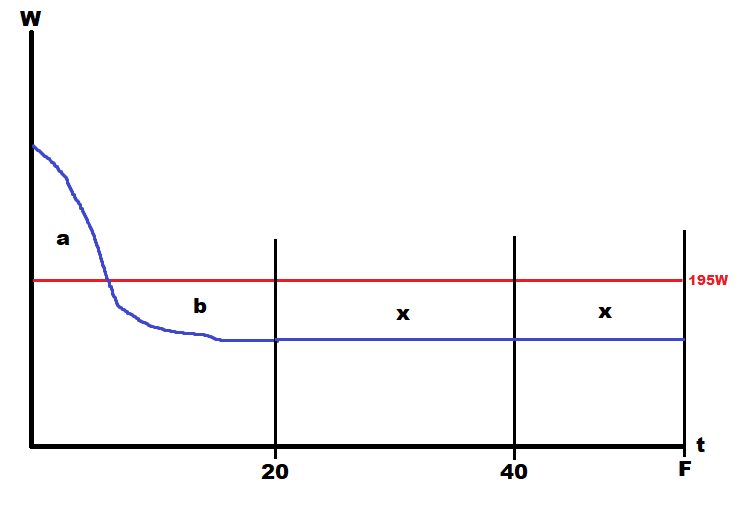
If you did find a suitable group, as in “the likely frontmost group that contains cat D riders who are registered on ZP and who won’t get a DQ”, then you could sit with them for a while. You can’t go on a solo breakaway for the last 35 min anyway, even if you come from cat A because you have a performance ceiling to respect and any chasing group on the limit will go faster than you due to draft effects. You will have to get caught even if you aren’t tired. So you might as well sit with the group and then try to drop them one by one or perhaps drop them all in some climb closer to the finish.
But strictly speaking, you are going well under limits and that is a waste. A legit rider may be forced to race at that sub-limit pace because his HR is high coming out of the first minutes, he never really gets a chance to recover fully, and his fitness level doesn’t allow him to stay on the limit for the remainder of the race. It’s not how his categorization was measured anyway. He isn’t measured by ZP on his actual 1 hr performance (or 55 min in this case) but rather his assumed 1 hr performance, which ZP gets from his previous best 20 min race efforts, which are more than likely coming from the first 20 min in three races the last 90 days. There is nothing in those measures supporting that he would actually be able to pull those numbers off for a full hour, and usually people can’t, not quite. That 20 min W * 0.95 is often an overly generous estimate of the 1 hr FTP, especially for a Zwifter who is often used to shorter rides.
You, on the other hand, are a cruiser. You have overcapacity. You could stay on the limit for the entire race. Look at the x‘s in the graph above. That’s unused potential. You should strive to minimize the x area, to push up that blue line as high as you can without going over limits, because that is one of the cruiser’s two strong edges against the legit (the second edge is being able to withstand harder over-limit efforts than others, which then need to be compensated for). That’s how you win as a cruiser. However, minimizing x has to make sense. You don’t go on early solo breakaways. But if there is a faster group that you could join, faster than the one you had to end the first 20 min block with to get your average down in time, then that may be what helps you use your full potential. Oh, and there is something else.
The Post-20 Min Push
Since a cruiser typically ends the latter part of the first 20 min block underutilizing his potential because he has to get his average down, something funny sometimes happens at race time 00:20:01. He is out of the first block. He managed his average. It is just below limit. He is safe for now. And that means that he can instantly jump right back up to limit like this (if it makes sense in the tactical situation):
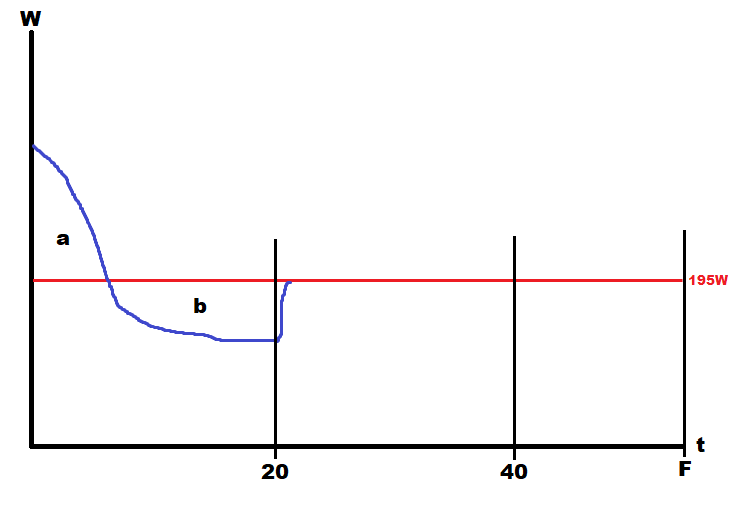
It’s a weird move but it follows naturally from the contrived 20 min rule of ZP’s. As long as the cruiser ended the first 20 min with an OK average, and as long as he doesn’t go over limit in the next block, then his previous 20 min are no longer a liability and won’t pull him down anymore.
In fact, while you always have to worry about high effort 20 min periods overlapping parts of two 20 min blocks, once the second 20 min block starts you can usually push it far more than just that little surge up to the limit shown above. You can actually push it like this or even harder:

The race scenario in the above graph could be that in the first 20 min you initially went with a bunch of sandbaggers in the early chaos, just to stay ahead of all legits. Then you had to drop to get your average down. You ended up in a slow moving group that helped your average. But while you were desperately grooming your average some riders from your group broke off or you were passed by faster riders from behind, and you couldn’t afford to latch on to them for fear of the health of your average.
Once the first 20 min are over, this group that helped you with the average just pulls you down and, you are not sure at this point, but perhaps those who passed you will become ZP approved contenders for the podium. But now you are no longer tied to the first 20 min. And those who passed you are still not that far ahead, just a few seconds. And their W/kg’s seem higher than your group’s although still low enough for you to be able to maintain your average during the next block by drafting on them. A firm push (x) and you could hook up with them and continue the race at a higher pace and secure your shot at the podium.
As long as the push area, x, ends up smaller than the recovery area, y, by the end of the second 20 min block your average will be fine. Or put differently, you will be fine as long as you compensate for the push by going under limits enough during the latter part of the second block, just like you did in the first block.
Dangerous Overlapping 20 Min Periods
But isn’t there a risk that you can get an overlapping 20 min period that goes over limit? If you haven’t actually got an app that tells the trailing 20 min average? You did manage the first block and on its own it turns out OK as an average. And you might have managed the second block too on its own. But isn’t there a possibility that you accidentally get a 20 min period somewhere in between 00:00:00 and 00:40:00 that goes higher than limit? Like the 20 min period within the green brace in the graph above?
There is always that risk to consider. And it’s an important point. But in the above example with the post-20 min push the risk is usually low or can at least be managed, although it comes down more to craft than to science, so to speak. I won’t go into detail to explain fully why, but as long as the race start was hard, with high Watts, and as long as your post-20 min push isn’t quite that hard, i.e. the Watts are somewhat lower this time, then you are OK. Because then you already compensated more than enough for the push by going under limits during the latter part of the first 20 min block. Going under limits paid for the hard start, but it also pays forward. It usually covers a later push just outside a 20 min block as long as the push in the new block isn’t harder than the push that the previous block was started with. And it rarely is harder.
There are situations, though, where a 20 min period can ruin everything. Luckily they don’t happen very often because race situations like that don’t occur very often, but it’s on you to make sure it stays that way. I’ll show you an artifical example of such a bad period:
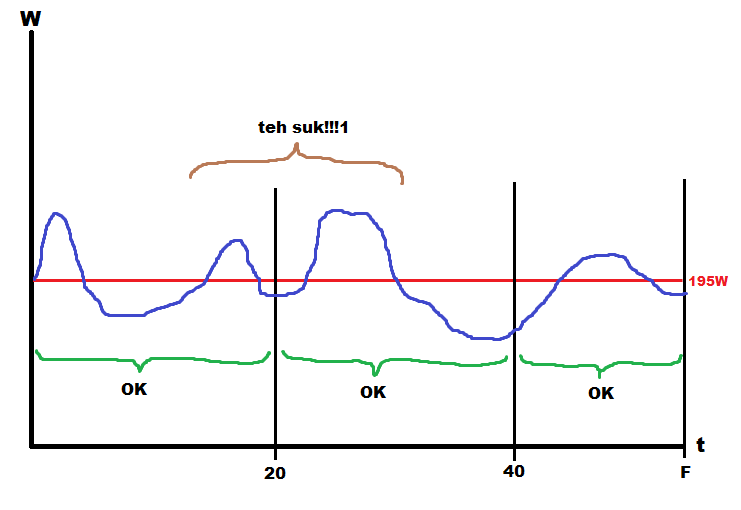
I don’t know exactly what the scenario would be. I was just showing off my Paint skills. But maybe something like this:
“So uh, the start was hard as usual, and then I compensated to get the average down and all, but then I wanted to bridge to another group because there was this guy in there who was dangerous-like, and it went fine, I got him in check, and the average for the first block still turned out OK in the end, but then came the KOM and everybody was climbing like monkeys and I had to hang in there, but then after that things kinda slowed down ‘cuz we were sortta toast, and then towards the finish there’s this little climb, you know, and I thought ‘imma make a move here!’ and I did and dropped those wrung-out monkey suckers and then basically just coasted over the finish line for a guaranteed gold on ZP! Yay! Hey… wait a min… what’s this? WKG?!”
Every block in the race is under limit (the green braces). But toward the end of the first block a 20 min period starts that unfortunately happens to include two surges that aren’t compensated for with enough under-limit area (the brown brace). Each of the two surges are covered for within their respective block, but combined in an overlapping 20 min period they are not. And this will result in a WKG and possibly an upgrade on ZP.
So if you can’t monitor a trailing 20 min average (I can’t yet), then you have to play the race and your memory of its parts by ear and just make sure you don’t stack over-limit efforts too closely. But wouldn’t your total race average warn you in advance? Not necessarily. If you have been going under limit for quite some time in a race that goes on for more than two blocks and then suddenly you start to push hard toward the end of a race, then the total average might not pick up fast enough for you to notice or realize that your trailing 20 min average is actually above limit.
Restarting the Clock
If you, like me, can’t actually monitor your trailing 20 min average (I would love to hear from you if you have found a way), then what do you do with the Wahoo app or similar and the numbers in it once the app clock hits 00:20:00 and the first block is over? Do you just let it run and try to rely on the total average Watt number, even though the information it gives becomes less and less fine-grained and reliable as the race progresses? Or do you simply stop the clock, reset it and start over, i.e. you measure actual separate 20 min block instead throughout the race?
Good question. It depends. I lean towards resetting as blocks end and usually end up doing just that. In most races it makes sense, or at any rate the alternative seems worse to me. We can take a look at this graph again with the post-20 min push that I showed earlier.

When the race clock hits 00:20:00 you know that your average is fine for now. You survived the dangerous first 20 min. You want to push next and you know it is likely safe to do so since you won’t be overdoing it. You want to make sure, though, that the next 20 min period starting with the push, basically the 20 min period coinciding with the second 20 min block, ends up alright. So stopping the clock at 00:20:00 and restarting it makes sense here. You can mostly forget about the past 20 min and you are mostly interested in monitoring your average for the upcoming 20 min as it builds up. And restarting the clock does just that for you.
Spring Break
This concludes the first part of Cheat School. You now know the (intricacies of the) basics of cruising. Try it out, get a hang of it and you will find that you can start winning a lot of races as a cruiser, races you really shouldn’t be able to keep winning indefinitely. And you will understand what a house of cards Zwift racing and its rules are. It’s sickening, yes, but this isn’t you. It’s Zwift, the German board game. And you have just learned to optimize your Zwift racing (which is nothing like bike racing). Cruising is the optimal, most efficient, most successful way to race in Zwift, in the ZP version of Zwift, in the “official” and respected version of Zwift. Now take a temporary break from school and go out there and have some questionable fun!
Tagged : Cheat School
